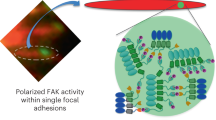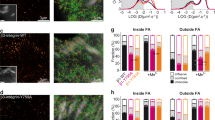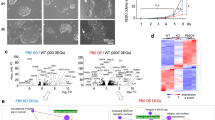Abstract
Extracellular matrix (ECM) components regulate neurite outgrowth in tissue culture and in vivo. Live imaging of phosphotyrosine (PY) signals revealed that Xenopus laevis growth cones extending on permissive ECM substrata assemble adhesive point contacts containing enriched levels of tyrosine-phosphorylated proteins. Whereas focal adhesion kinase (FAK) signaling is dispensable for the assembly of focal adhesions in non-neuronal cells, FAK activity is required for the formation of growth cone point contacts. FAK-dependent point contacts promote rapid neurite outgrowth by stabilizing lamellipodial protrusions on permissive ECM substrata. Moreover, local FAK activity is required for ECM-dependent growth cone turning in vitro, suggesting that FAK may control axon pathfinding in vivo. Consistent with this possibility, proper growth and guidance of Rohon-Beard sensory neurons and spinal commissural interneurons requires FAK activity. These findings identify FAK as a key regulator of axon growth and guidance downstream of growth cone–ECM interactions.
This is a preview of subscription content, access via your institution
Access options
Subscribe to this journal
Receive 12 print issues and online access
$209.00 per year
only $17.42 per issue
Buy this article
- Purchase on Springer Link
- Instant access to full article PDF
Prices may be subject to local taxes which are calculated during checkout








Similar content being viewed by others
References
Roberts, A. & Taylor, J.S. A scanning electron microscope study of the development of a peripheral sensory neurite network. J. Embryol. Exp. Morphol. 69, 237–250 (1982).
Easter, S.S., Jr., Bratton, B. & Scherer, S.S. Growth-related order of the retinal fiber layer in goldfish. J. Neurosci. 4, 2173–2190 (1984).
Anderson, H. & Tucker, R.P. Pioneer neurones use basal lamina as a substratum for outgrowth in the embryonic grasshopper limb. Development 104, 601–608 (1988).
Ide, C., Tohyama, K., Yokota, R., Nitatori, T. & Onodera, S. Schwann cell basal lamina and nerve regeneration. Brain Res. 288, 61–75 (1983).
Scherer, S.S. & Easter, S.S., Jr. Degenerative and regenerative changes in the trochlear nerve of goldfish. J. Neurocytol. 13, 519–565 (1984).
Yaginuma, H., Homma, S., Kunzi, R. & Oppenheim, R.W. Pathfinding by growth cones of commissural interneurons in the chick embryo spinal cord: a light and electron microscopic study. J. Comp. Neurol. 304, 78–102 (1991).
Bernhardt, R.R. Ipsi- and contralateral commissural growth cones react differently to the cellular environment of the ventral zebrafish spinal cord. J. Comp. Neurol. 350, 122–132 (1994).
Hoang, B. & Chiba, A. Genetic analysis on the role of integrin during axon guidance in Drosophila. J. Neurosci. 18, 7847–7855 (1998).
Bonner, J. & O'Connor, T.P. The permissive cue laminin is essential for growth cone turning in vivo. J. Neurosci. 21, 9782–9791 (2001).
Paulus, J.D. & Halloran, M.C. Zebrafish bashful/laminin-alpha1 mutants exhibit multiple axon guidance defects. Dev. Dyn. 235, 213–224 (2006).
Kleitman, N. & Johnson, M.I. Rapid growth cone translocation on laminin is supported by lamellipodial not filopodial structures. Cell Motil. Cytoskeleton 13, 288–300 (1989).
Zacharias, U., Leuschner, R., Norenberg, U. & Rathjen, F.G. Tenascin-R induces actin-rich microprocesses and branches along neurite shafts. Mol. Cell. Neurosci. 21, 626–633 (2002).
Geiger, B., Bershadsky, A., Pankov, R. & Yamada, K.M. Transmembrane crosstalk between the extracellular matrix–cytoskeleton crosstalk. Nat. Rev. Mol. Cell Biol. 2, 793–805 (2001).
Guan, J.L., Trevithick, J.E. & Hynes, R.O. Fibronectin/integrin interaction induces tyrosine phosphorylation of a 120-kDa protein. Cell Regul. 2, 951–964 (1991).
Kornberg, L., Earp, H.S., Parsons, J.T., Schaller, M. & Juliano, R.L. Cell adhesion or integrin clustering increases phosphorylation of a focal adhesion-associated tyrosine kinase. J. Biol. Chem. 267, 23439–23442 (1992).
Ilic, D. et al. Reduced cell motility and enhanced focal adhesion contact formation in cells from FAK-deficient mice. Nature 377, 539–544 (1995).
Volberg, T., Romer, L., Zamir, E. & Geiger, B. pp60(c-src) and related tyrosine kinases: a role in the assembly and reorganization of matrix adhesions. J. Cell Sci. 114, 2279–2289 (2001).
Gomez, T.M., Roche, F.K. & Letourneau, P.C. Chick sensory neuronal growth cones distinguish fibronectin from laminin by making substratum contacts that resemble focal contacts. J. Neurobiol. 29, 18–34 (1996).
Wu, D.Y. & Goldberg, D.J. Regulated tyrosine phosphorylation at the tips of growth cone filopodia. J. Cell Biol. 123, 653–664 (1993).
Robles, E., Woo, S. & Gomez, T.M. Src-dependent tyrosine phosphorylation at the tips of growth cone filopodia promotes extension. J. Neurosci. 25, 7669–7681 (2005).
Krotoski, D. & Bronner-Fraser, M. Distribution of integrins and their ligands in the trunk of Xenopus laevis during neural crest cell migration. J. Exp. Zool. 253, 139–150 (1990).
Somasekhar, T. & Nordlander, R.H. Differential distributions of HNK-1 and tenascin immunoreactivity during innervation of myotomal muscle in Xenopus. Brain Res. Dev. Brain Res. 88, 53–67 (1995).
Mitra, S.K., Hanson, D.A. & Schlaepfer, D.D. Focal adhesion kinase: in command and control of cell motility. Nat. Rev. Mol. Cell Biol. 6, 56–68 (2005).
Hens, M.D. & DeSimone, D.W. Molecular analysis and developmental expression of the focal adhesion kinase pp125FAK in Xenopus laevis. Dev. Biol. 170, 274–288 (1995).
Calalb, M.B., Polte, T.R. & Hanks, S.K. Tyrosine phosphorylation of focal adhesion kinase at sites in the catalytic domain regulates kinase activity: a role for Src family kinases. Mol. Cell. Biol. 15, 954–963 (1995).
Schaller, M.D., Borgman, C.A. & Parsons, J.T. Autonomous expression of a noncatalytic domain of the focal adhesion-associated protein tyrosine kinase pp125FAK. Mol. Cell. Biol. 13, 785–791 (1993).
Galbraith, C.G., Yamada, K.M. & Sheetz, M.P. The relationship between force and focal complex development. J. Cell Biol. 159, 695–705 (2002).
Mitchison, T. & Kirschner, M. Cytoskeletal dynamics and nerve growth. Neuron 1, 761–772 (1988).
Suter, D.M. & Forscher, P. Substrate-cytoskeletal coupling as a mechanism for the regulation of growth cone motility and guidance. J. Neurobiol. 44, 97–113 (2000).
Taylor, J.S. & Roberts, A. The early development of the primary sensory neurones in an amphibian embryo: a scanning electron microscope study. J. Embryol. Exp. Morphol. 75, 49–66 (1983).
Hirose, G. & Jacobson, M. Clonal organization of the central nervous system of the frog. I. Clones stemming from individual blastomeres of the 16-cell and earlier stages. Dev. Biol. 71, 191–202 (1979).
Inoue, A., Takahashi, M., Hatta, K., Hotta, Y. & Okamoto, H. Developmental regulation of islet-1 mRNA expression during neuronal differentiation in embryonic zebrafish. Dev. Dyn. 199, 1–11 (1994).
Jacobson, M. Rohon-Beard neuron origin from blastomeres of the 16-cell frog embryo. J. Neurosci. 1, 918–922 (1981).
Liu, Y. & Halloran, M.C. Central and peripheral axon branches from one neuron are guided differentially by Semaphorin3D and transient axonal glycoprotein-1. J. Neurosci. 25, 10556–10563 (2005).
Somasekhar, T. & Nordlander, R.H. Selective early innervation of a subset of epidermal cells in Xenopus may be mediated by chondroitin sulfate proteoglycans. Brain Res. Dev. Brain Res. 99, 208–215 (1997).
Ruest, P.J., Roy, S., Shi, E., Mernaugh, R.L. & Hanks, S.K. Phosphospecific antibodies reveal focal adhesion kinase activation loop phosphorylation in nascent and mature focal adhesions and requirement for the autophosphorylation site. Cell Growth Differ. 11, 41–48 (2000).
Sieg, D.J. et al. Pyk2 and Src-family protein-tyrosine kinases compensate for the loss of FAK in fibronectin-stimulated signaling events but Pyk2 does not fully function to enhance FAK- cell migration. EMBO J. 17, 5933–5947 (1998).
Menegon, A. et al. FAK+ and PYK2/CAKbeta, two related tyrosine kinases highly expressed in the central nervous system: similarities and differences in the expression pattern. Eur. J. Neurosci. 11, 3777–3788 (1999).
Suter, D.M. & Forscher, P. Transmission of growth cone traction force through apCAM-cytoskeletal linkages is regulated by Src family tyrosine kinase activity. J. Cell Biol. 155, 427–438 (2001).
Clarke, J.D., Holder, N., Soffe, S.R. & Storm-Mathisen, J. Neuroanatomical and functional analysis of neural tube formation in notochordless Xenopus embryos; laterality of the ventral spinal cord is lost. Development 112, 499–516 (1991).
Matise, M.P., Lustig, M., Sakurai, T., Grumet, M. & Joyner, A.L. Ventral midline cells are required for the local control of commissural axon guidance in the mouse spinal cord. Development 126, 3649–3659 (1999).
Brankatschk, M. & Dickson, B.J. Netrins guide Drosophila commissural axons at short range. Nat. Neurosci. 9, 188–194 (2006).
Ren, X.R. et al. Focal adhesion kinase in netrin-1 signaling. Nat. Neurosci. 7, 1204–1212 (2004).
Li, W. et al. Activation of FAK and Src are receptor-proximal events required for netrin signaling. Nat. Neurosci. 7, 1213–1221 (2004).
Liu, G. et al. Netrin requires focal adhesion kinase and Src family kinases for axon outgrowth and attraction. Nat. Neurosci. 7, 1222–1232 (2004).
Gomez, T.M., Harrigan, D., Henley, J. & Robles, E. Working with Xenopus spinal neurons in live cell culture. Methods Cell Biol. 71, 129–156 (2003).
Gomez, T.M., Robles, E., Poo, M. & Spitzer, N.C. Filopodial calcium transients promote substrate-dependent growth cone turning. Science 291, 1983–1987 (2001).
Moon, M.-S. & Gomez, T.M. Adjacent pioneer commissural interneuron growth cones switch from contact avoidance to axon fasciculation after midline crossing. Dev. Biol. 288, 474–486 (2005).
Robles, E., Huttenlocher, A. & Gomez, T.M. Filopodial calcium transients regulate growth cone motility and guidance through local activation of calpain. Neuron 38, 597–609 (2003).
Acknowledgements
We thank M. Halloran and members of the Gomez lab for comments on the manuscript. This work was supported by grant NS41564 from the US National Institutes of Health (to T.M.G.) and by a National Science Foundation predoctoral fellowship (to E.R.).
Author information
Authors and Affiliations
Corresponding author
Ethics declarations
Competing interests
The authors declare no competing financial interests.
Supplementary information
Supplementary Fig. 1
FRNK expression and FAKmo loading impair FAK activity and reduce PY levels at the growth cone. (PDF 1504 kb)
Supplementary Video 1
Dual-colored image sequence of a growth cone on LN expressing DsRed (red) and GFP-dSH2 (green). Note the robust GFP-dSH2 enrichment within stable point contacts (indicated by yellow arrowheads) and at the tips of motile filopodia. Time lapse, 30X. (MOV 5671 kb)
Supplementary Video 2
Fluorescence image sequence of a GFP-FRNK expressing Xenopus spinal neuron growth cone on LN. Note long, stable filopodia and dynamic, unstable lamellipodial protrusions. Time lapse, 60X. (MOV 4710 kb)
Supplementary Video 3
Fluorescence image sequence of a GFP-expressing Xenopus spinal neuron growth cone on LN (blue) at an interface with substratum-bound TN. Note that many transient lamellipodial protrusions extend onto the TN region but are rapidly withdrawn, while lamellipodia extending onto the LN region are stabilized and become the new leading edge. At t=610s this growth cone was fixed and subsequently stained for phospho-FAK. Note presence of phospho-FAK puncta only within lamellipodia on LN (arrowheads). Time lapse, 60x. (MOV 7411 kb)
Rights and permissions
About this article
Cite this article
Robles, E., Gomez, T. Focal adhesion kinase signaling at sites of integrin-mediated adhesion controls axon pathfinding. Nat Neurosci 9, 1274–1283 (2006). https://doi.org/10.1038/nn1762
Received:
Accepted:
Published:
Issue Date:
DOI: https://doi.org/10.1038/nn1762
This article is cited by
-
Integrin-mediated electric axon guidance underlying optic nerve formation in the embryonic chick retina
Communications Biology (2023)
-
Phosphorylation of Focal Adhesion Kinase at Y925: Role in Glia-Dependent and Independent Migration through Regulating Cofilin and N-Cadherin
Molecular Neurobiology (2022)
-
MARCKS regulates neuritogenesis and interacts with a CDC42 signaling network
Scientific Reports (2018)
-
Abundant Focal Adhesion Kinase Causes Aberrant Neuronal Migration Via Its Phosphorylation at Tyr925
Journal of Molecular Neuroscience (2018)
-
A novel culture platform for fast proliferation of human annulus fibrosus cells
Cell and Tissue Research (2017)



